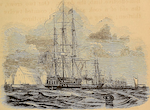Specifications:
Displacement 144 t.
Length 88'
Beam 21'9"
Depth of Hold 8'5"
Draft unknown
Speed unknown
Complement 17
Armament none
Propulsion Sail
Advance (I)
Dictionary of American Naval Fighting Ships
| Back To The Navsource Photo Archives Main Page | Back To The Old Navy" Steam and Sail Index |
| Comments, Suggestions, E-mail Webmaster. |
|
This page is created by Gary P. Priolo and maintained by Michael Junge |
